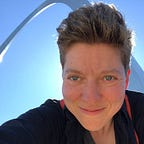Learnings from pop-up ice cream.
In my previous post, I mentioned partnering with Weckerly’s to run a pop-up ice cream stand at the Barnes. This was a pilot to help us test out some ideas about traffic flow while providing an added extra to visitors — we wondered what would happen when you put something very “different” onto our site. How would traffic patterns be affected? What could we learn?
Turns out, a lot more than we thought.
Over the two week period the cart moved around quite a bit allowing us to see how different interventions worked or didn’t. In the first week, we tested near our guest services center (GSC), which is a small building where we sell tickets. This location is off our valet driveway and the paths leading to it are a bit convoluted for visitors. Often we find visitors don’t immediately assume the GSC is a place where they can/should go. Some paths lead to it and others don’t, there’s a lack of signage, and, to a degree, the lack of clear purpose and pathways give the impression that it’s closed even when it’s open.
Once the ice cream cart was there, the atmosphere changed — the cart created a visual presence in an otherwise very constrained visual landscape. People from across the street would see the cart and it was clear something was going on over here. Eventually, we setup tables and chairs in this area and that worked well to grow the footprint of the operation. All of a sudden something came to life.
The lessons for the GSC actually turned out to be important ones when we started to pair them with Arup’s recommendations. If you remember, Arup was coming in to help us with wayfinding and a key finding in that process included identifying that the GSC was not an effective ticketing center. Simply put, because all paths don’t lead to the GSC there’s no funnel ensuring that people go there first, get a ticket, and flow through it to our entrance. Often, people miss the GSC completely, arrive at our entrance, and just get a ticket in our lobby. Arup is recommending we streamline our ticketing process by limiting ticketing transactions to our lobby where we have an effective funnel. They are suggesting we find a creative reuse of the GSC and eliminate ticketing at this location to avoid confusion.
Pop-up ice cream near the GSC taught us we can do something at this location, but it will likely need a real presence. Just putting something else in the GSC building and opening the door probably won’t do it — we need to think about how to activate the exterior to help lead people to what’s inside. One consideration is how “different” that may need to look to help offset the formalism of the building and help indicate to visitors that this is something for them. What the GSC will eventually become is something we are just beginning to explore, but we have a sense of what might be part of the puzzle as a result of this pilot.
The other fascinating thing to see was how the presence of the cart differed when it was located on our fountain plaza. The GSC is a small, constrained area and the cart could really visually stand out in that location. The plaza is a large, expansive area and the cart just couldn’t visually compete no matter how foreign it was on our grounds. The building, the trees, shadows, the plaza totally swallowed it up. Prior to this point, the building seemed delicate on the property; set back and nestled on the site. What ice cream helped demonstrate is just how powerful and commanding this building and its site actually are. The building may seem delicate and tucked away, but it’s actually more present than you can imagine.
This type of learning is incredibly important as we start to activate our plaza and work to better identify the building to visitors. Both will likely need big, bold strokes if we hope to create a visual language that can “read” given the current landscape. There’s nothing more gratifying than sitting with our manager of public programs, Kathleen Greene, going through photos of the ice cream cart on the plaza and talking about how to ensure that the plaza activations she’s planning can be seen/found/noticed by the public.
We had originally thought the ice cream pilot would help inform us about traffic patterns, but what we got were some bigger picture learnings that we didn’t expect. That said, I can’t deny the personal bonus of testing in this way. Learnings are one thing, but getting to eat an amazing amount of really good ice cream sandwiches while doing visitor observation is another.
